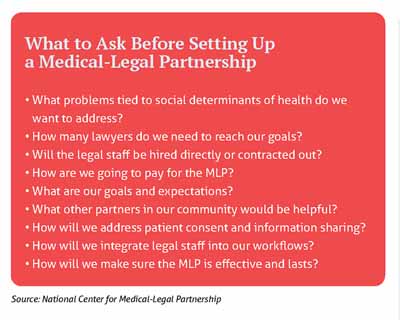
There's no doubt that medical-legal partnerships (MLPs) have been a valuable addition to many types of medical practice, says Louis Appel, MD, chief medical officer and director of pediatrics at People’s Community Clinic in Austin.
An MLP can form when at least one medical entity creates a formal relationship with at least one legal entity to improve health care. For instance, the MLP at People’s, a federally qualified health center, has two lawyers and a paralegal who work directly with the physicians and other medical staff to address patient needs, Dr. Appel says.
MLPs are especially helpful for patients whose medical conditions are worsened by social determinants of health – the factors outside the clinic that affect a patient’s well-being, such as housing problems.
“I’ve had patients with asthma where there’s some issue with the apartment they’ve rented with mold or [tobacco smoke from a neighbor] that comes into the apartment that’s triggering the asthma,” Dr. Appel said. “I’ve been able to use the MLP [approach] to assist families in getting out of the lease or in getting their apartment changed so that they’re not having mold or smoke come in from a neighboring unit.”
MLPs can help physicians address a range of issues, including public benefits, insurance, education, guardianship, immigration, and special education, says attorney Cecile Carson. She is associate director of Texas Legal Services Center, which runs the legal side of the People’s Community Clinic MLP. (See "IHELP," page 25.)

And the structure of MLPs can vary, depending on their funding and patient needs, experts say. Some lawyers may work in the same building as the medical practice; others – particularly in rural areas – may not. The important feature is they are readily available to accept referrals of a patient with an immediate legal need.
“Once you’ve seen one medical-legal partnership, you’ve seen one medical-legal partnership,” explained Houston attorney Sheri Dacso. She serves on the executive committee of the Texas Medical-Legal Partnership Coalition and has helped set up MLPs. “There’s not really a cookie-cutter structure. They have to reflect the nature of the goals of the institutional relationship. You have to understand what it is you want to accomplish – why do you want a medical-legal partnership? What is it going to do? What are you looking for in terms of outcomes?”
Whatever their structure, numerous studies have shown that MLPs can improve health care. A March 2022 study published in Health Affairs compared health outcomes for children referred to an MLP tied to a pediatric primary care center with the outcomes for children who were not referred. It found that children whose cases were referred to an MLP were much less likely to be hospitalized.
Texas is home to 18 of the 450 MLPs in the U.S., according to the National Center for Medical-Legal Partnership (NCMLP) in Washington, D.C. And while not every medical practice needs an MLP, just about any specialty providing direct patient care can benefit from the arrangements to improve health outcomes, Dr. Appel says.
“The MLP really provides a tool to help patients with issues that are not strictly medical but are having an impact on their health,” he said. “Having an MLP is helpful for any medical practice if they want to engage these upstream issues that affect patient health.”
Physicians interested in forming an MLP should first ask and answer a series of questions, says Austin lawyer Keegan Warren-Clem, who helped set up the MLP at People’s Community Clinic and now consults with medical practices. Many of these are spelled out in the NCMLP toolkit for establishing an MLP. (See “What to Ask Before Setting Up an MLP,” page 26.)

“If you haven’t, for instance, come up with a definition for success or for what outcomes you’re trying to achieve, I think it is more likely you’ll be disappointed down the road,” Ms. Warren-Clem said.
In many cases, both physicians and lawyers struggle to understand that a true MLP is a partnership, and while many lawyers contribute time and expertise to MLPs, they are not simply doing charity work, Ms. Dacso says.
Depending on the MLP, the lawyers might work as direct employees or as contractors, and they might work on site or in their own offices. Either way, they’re most effective when they’re an integrated part of the care team, she says.
Funding for MLPs can take many forms, depending on the medical and legal organizations involved, Ms. Warren-Clem says. On the legal side, funding can come from law schools, legal nonprofit funds, legal fellowships, or state-operated programs designed to provide legal assistance for people with low incomes.
Hospitals, large clinics, and managed care frequently provide at least some of the financing out of their own budgets, she says. Meanwhile, smaller physician offices often fund MLPs through philanthropy or by combining resources with other physician offices or clinics. Several states have used more innovative approaches, such as including legal services in a Medicaid managed care contract or other value-based payment arrangement.
“I think we will see an increase in [financial] incentives for MLPs as value-based purchasing becomes the norm,” Ms. Warren-Clem said.
In addition to the various financial arrangements, both law and medicine are highly regulated fields, Ms. Warren-Clem says. Those regulations should not stop an MLP from being formed, but they are an important consideration when physicians choose their partners.
For instance, legal entities that take federal money cannot work on behalf of undocumented immigrants in certain situations, she said. A physician’s office that serves immigrants needs to clarify these types of funding limitations with a potential legal partner.
And while many MLPs are designed to help low-income and medically underserved populations, practices with predominantly middle-class patients also can benefit, says lawyer Bethany Hamilton, co-director of NCMLP. Even middle-class families, for instance, can face serious health-related legal problems – like surprise billing or substandard housing – but cannot afford to hire a lawyer.
“Imagine you’re in a domestic violence situation, and you’re able to get to your physician’s office, but you have that legal problem. And because you [make too much money to obtain free legal assistance] you can’t get legal advice to help you navigate out of that situation,” she said.
A medical practice’s need for an MLP should be based more on the need for legal help to resolve medical problems than on economic class, Ms. Carson says.
“A lot of it has to do with a physician asking himself or herself the question, ‘Am I hearing about patient legal issues, and [do I] need to refer them to somebody about it?’” she said.
No matter the patient population, the medical entity and the legal entity considering an MLP should make sure their missions are complementary before they strike up an official partnership, Ms. Warren-Clem says.
“It is important to be aligned in terms of populations to be served and outcomes to be achieved – how those will be recorded, tracked, measured, and reported,” she said. “By being thoughtful about populations, an MLP can be an important tool for increasing health equity.”
MLP lawyers can help a medical practice in ways other than specific legal cases, Ms. Warren-Clem says. For instance, they can train staff on the impact of social determinants of health and even help explain why some patients exhibit puzzling behaviors, such as consistently no-showing for appointments or repeatedly delaying prenatal care.
“These types of patterns can suggest that a group of patients is reacting to a structural barrier or change,” she said. “And MLP attorneys are experts at connecting health behaviors and law to solve problems.”
MLPs also can effect change at both the clinic and governmental levels. For instance, an MLP lawyer at People’s Community Clinic helped change its policy on how interpersonal violence and abuse are reported. And when record freezing temperatures hit Texas in February 2021, MLPs joined a coalition of other groups to meet with public utilities and argue against turning off power or gouging customers afterward.
“We had calls [from patients] coming in in real time that we could share,” Ms. Carson said.
Most of the legal work MLPs do is outside the courts, Dr. Appel says.
“It’s extremely unusual that the MLP lines up actual litigation with anyone,” he said. “They’re able to provide counseling and guidance [to patients]. Sometimes, they might write a letter from the attorney explaining something to a landlord or a school, and the family having that information is usually all that’s needed.”
Incorporating an MLP into the workings of a medical organization takes time and training, but it pays off in improved patient outcomes, Ms. Dacso says. Many MLPs hire a social worker or some other patient champion to help smooth the transition by tracking cases, providing nonlegal counseling to patients, and serving as a go-between with the medical and legal staff members.
“The physician, the social worker, and the attorney are key to a successful MLP,” she said.